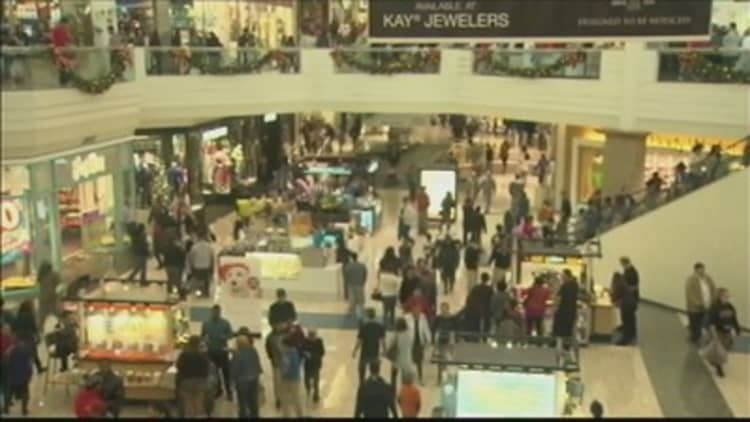
The death of the mall has been greatly exaggerated. Yet as online shopping and a wave of store closings continue to erode sales at these shopping centers, a new report has found that softness is starting to creep into their economics.
According to research by Green Street Advisors, for the first time since the recession, occupancy at malls is declining, and market rents appear to be slowing.
In a report released late Tuesday, the real estate research firm said it now expects same-tenant sales will grow 1.2 percent between 2016 and 2019. That's down from last year's forecast for 2.6 percent gains over the same time frame, and represents a decline from last year's 4 percent growth.
Similarly, market rent growth is expected to rise 1.5 percent during the four years ending in 2019, compared to the firm's prior forecast for 2.5 percent growth.
According to the Green Street, the biggest factors weighing on malls' fundamentals include the rise of online shopping; weakness at traditional "anchor" locations — in particular, department stores; and softer demand from retailers, who are working to prune unproductive square footage from their fleets.
"Tenant sales growth rebounded in '15 after decelerating in the previous few years," senior analyst D.J. Busch said. "However, much of the increases were driven by the fallout of unproductive retailers that went bankrupt."
Though Busch said bankruptcies may continue to inflate tenants' same-store sales results, "organic" sales growth — which more accurately depicts comparable trends at a retail center — is expected to be low over the next several years.
These bankruptcies and other store closings have caused occupancy rates among nonanchor tenants to fall slightly last year, to below 95 percent. For example, mall-based retailers including Gap, Aéropostale and Finish Line are all in various stages of closing more than 100 stores. Green Street does not track occupancy rates for anchor tenants.
Though much attention has been placed on stores such as Sears and Macy's closing up shop, "anchor" locations account for just a small chunk of a mall's operating income. Instead, they're more critical to driving traffic to a location.
Still, analysts contend these store closings underline the fact that the U.S. has too much retail space. For instance, Sears Holdings recently closed nearly 600 stores in a one-year period, and the company said earlier this month that it will be shutting more locations in 2016. Macy's is also preparing to close 36 stores across the U.S. in an effort to boost its bottom line.

Often, when a retailer decides to close a store, it's because it's located in a struggling mall. According to Green Street, the U.S. is home to 1,100 regional and "super-regional" malls, which tend to be larger and offer more variety. Yet as the firm's research shows, not all malls are created equal.
Whereas the top malls rake in roughly $965 a square foot, those on the other end of the spectrum bring in just $130 per square foot. All in, Green Street estimates the top 300 malls account for 75 percent of the sector's value.
"[Net operating income] growth should be healthy for higher-quality malls, but lower-productivity centers should struggle due to softening retailer demand and the 800-pound gorilla ... e-commerce," Busch said. "Several will go dark."
Though the shift to online shopping is no doubt playing a role in lighter foot traffic at malls, there's more to their changing economics than the rise of Amazon. Changing demographics in a town are another reason a shopping center could struggle or fail — for example, if massive layoffs in a particular industry cause people to move away to find employment.
"A lot of people want to try and tie it to the Internet or 'that's not cool,' or teens don't like it," Jesse Tron, a spokesman for industry trade group International Council of Shopping Centers, told CNBC last year. "It's hard to support large-format retail in those suburban areas when people are trying to just pay their mortgage."





